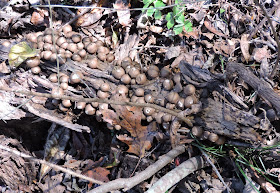Becky Swearingen shared her photographs and this story of a newly burned prairie.
I. Freshly Burned Prairie
On September 18th I decided to visit around the Lockwood area and ended the day at Niawathe Prairie. This was the day the Master Naturalists had intended to visit so it seemed appropriate. Ends up the north side of the prairie was recently burned and while I always find it sad to see a burned prairie, I know it is best for the prairie’s health.

The advantage for a photographer is that it allows one to see things that would normally be hidden in the prairie’s lush growth. I saw several snake skins, one of which I think actually was not a skin but a snake that was a victim of the fire.
 |
| Shed snake skin |
Victim of the fire? Hard to tell, but there seemed to be flesh.
This crispy critter was definitely a fire victim.

But there was life among the ashes. This larval
Glowworm Beetle came wandering through. I would have never seen it if there had not been fire.

There were lots and lots of grasshoppers. Hopefully they like their grass well done. This
Differential Grasshopper stood out against the burned prairie floor.

And several varieties of moths. This one is probably a webworm moth of some variety.

A
Chorus Frog came hopping by, unconcerned by the blackened dry prairie floor. It was camouflaged with its black stripes matching the burned grass stalks.


Life is returning to the scorched ground already.

Next spring a healthier prairie will come back to life. The seed head below, pale and delicate yet somehow surviving the conflagration and is ready to create new plants.

And as I left the prairie that evening I saw one of the beneficiaries of a healthy prairie, a
Northern Bobwhite, looking for a home for the winter. The quail chicks will be the size of a fingernail and start hunting insects on day one. The open spaces between the bunches of fresh prairie grass are necessary for their survival, one more reason to burn.
II. Burned Prairie Redux
Redux means “brought back” and that is what is happening at Niawathe a week after I first visited the burned out prairie. Already there is lots of green and even a few early flowers.

Among the new life, I did find signs of the old. Most interestingly, I found these tiny skeletal remains. A result of the fire? I don’t know.
I also found an egg. This one has been there for a while I believe as it had dirt on the inside.

This millipede was going about its business. It is too young to identify the specific variety. It was a little perturbed with me when I moved it to the ground to get a better picture but soon continued on its way.

There was a small group of
Horned Larks that were flying around and feeding among the new grass shoots. They prefer open ground with short grass. Herds of bison provided this but freshly burned prairie is a good substitute.

The
katydids are very visible against the blackened earth.
I think my favorite find was this
Spider Wasp (Psorthaspis). Its bright orange stripes stood out quite boldly against the dark earth.

Less boldly colored was this Common Checkered Skipper -
Pyrgus communis.
From its behavior it appeared to be laying eggs.
This lively cricket blended in with the blackened soil. Its natural color provides good camouflage against the burned prairie.

I moved back to the road after walking through the burned area for an hour or so, finding this beautiful and tiny
Pencil Flower.
And then saw a gleam of white. As I examined it I found a Meadow Katydid on the remains of a small animal’s vertebra. Even after a burn some green survives, both in plants and animals.


















































